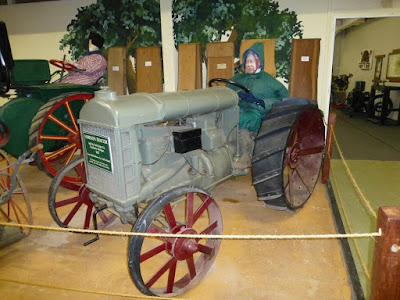Local treasures of Bicton’s Countryside Museum
Continued from
That’s a largish area, extending as far as the village
of Newton Poppleford, and with so many aspects. Off-hand, I can’t think of too
many items at Fairlynch which are to do with farming or agriculture, which play
an important role in our area.
Bicton’s Countryside Museum is bursting with such
items. Not all of them are local. This Fordson tractor, built by
the Ford Motor Company at Dearborn, in Michigan, USA, dates from 1917 and is
probably one of the oldest in the country.
It came from Mitchelstown, in Co Cork, Ireland.
But there are many items given by local donors, which reflect the support given to the Bicton museum’s founder, Colonel ‘Jimmy’ James, in his quest to preserve the local heritage.
Farming items include this advertisement
for a sale held at Hill Farm, in East Budleigh, in 1911. It was presented by
Mrs K. Turner of Pavers Farm, Otterton.
A useful explanation comes from the Legendary Dartmoor website: ‘The very reason any
oral treatment was called a “drench” was that many of the early medicines were
basically lethal and had to be well diluted, this resulted in a massive dose
which was literally poured or “drenched” down the animal’s throat. If you were
to dose a lamb for worms today you would administer about 2.5ml/10kg of wormer,
one hundred years ago you would probably pour about 560ml down through the
horn.’ http://www.legendarydartmoor.co.uk/sheep_moor.htm
Among
the various household items in the Countryside Museum is this acetylene lamp
dating from around 1925 and presented by Mrs F.J. Harding of Hayes Lane in East
Budleigh.
Compared with modern cycle
lights, this old lamp, which relied on the action of water dripping onto
calcium carbide to produce inflammable acetylene gas, seems a clumsy
affair. But Wikipedia at https://en.wikipedia.org/wiki/Carbide_lamp tells me that some cavers today still use
acetylene lamps.
Pic:
ad for Union Carbide https://upload.wikimedia.org/wikipedia/commons/d/d9/Gas_Lighting.jpg
The
fine brass sundial face is dated 1710 and was given by Mr A.J. Patch, of
Colaton Raleigh.
He also gave this
lemonade bottle, inscribed 'M.L. Perriam, Wine and Spirit Merchant Salterton.'
In
my next posting about interesting stuff at the fascinating Bicton Countryside
Museum I will present some artefacts
concerning cider-making in the Lower Otter Valley.











Comments
Post a Comment